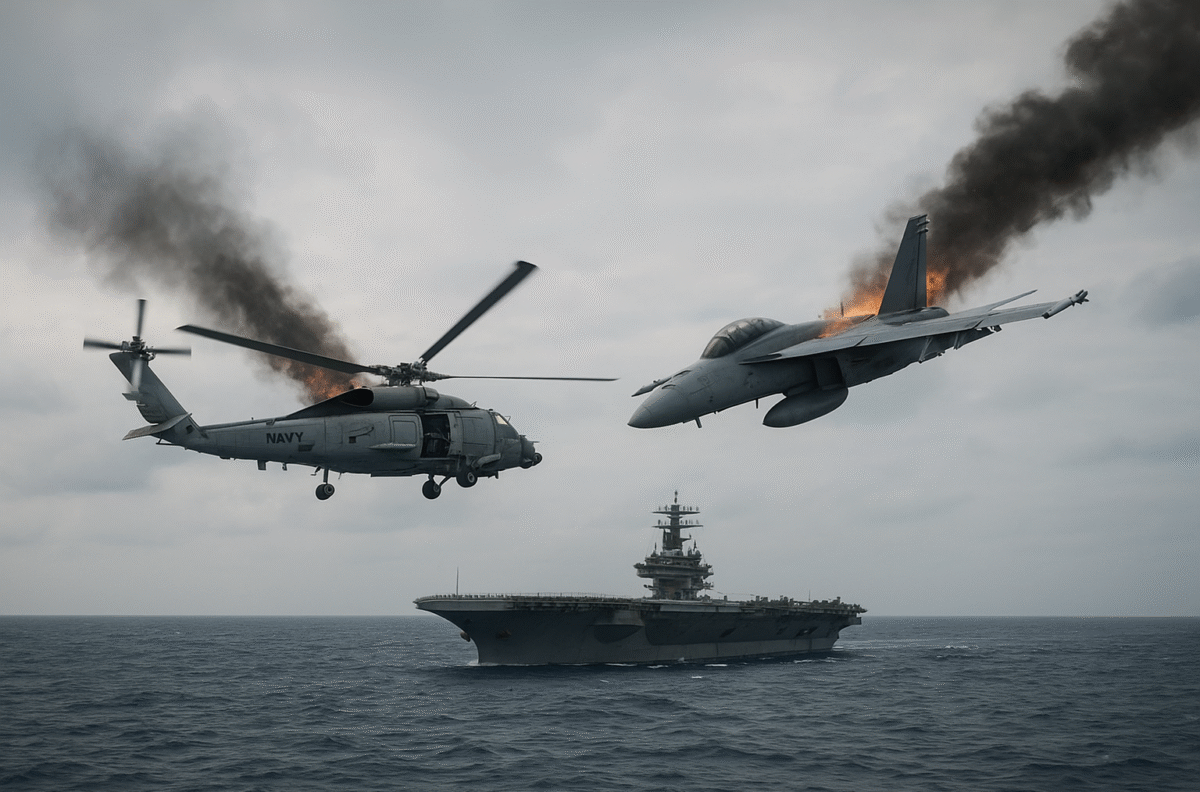Why did two U.S. Navy aircraft crash within minutes in the South China Sea? Shocking details emerge

Why did two U.S. Navy aircraft crash within minutes in the South China Sea? Shocking details emerge
Two U.S. Navy aircraft — a Seahawk helicopter and a Super Hornet fighter jet — plunged into the South China Sea on Sunday during separate routine missions from the USS Nimitz, America’s oldest nuclear-powered aircraft carrier. According to the U.S. Pacific Fleet, the incidents occurred just 30 minutes apart, raising questions about possible mechanical issues or external factors affecting flight operations in the volatile region.
The first crash involved an MH-60R Sea Hawk helicopter that went down around 2:45 p.m. local time while carrying out standard maneuvers. The Navy confirmed that all three crew members were swiftly rescued and are in stable condition.
Roughly half an hour later, at about 3:15 p.m., an F/A-18F Super Hornet jet attached to the “Fighting Redcocks” squadron of Strike Fighter Squadron (VFA) 22 also crashed while performing a separate routine mission from the Nimitz. Both pilots ejected safely and were recovered from the sea.
“All personnel involved are safe and in stable condition. The cause of both incidents remains under investigation,” the U.S. Pacific Fleet said in a statement posted on X (formerly Twitter).
A Rare Double Mishap Raises Questions
Back-to-back aircraft losses within such a short timeframe are considered highly unusual, even for military operations conducted over complex maritime zones. Though the Navy has not confirmed the cause, speculation is growing that contaminated fuel, technical malfunction, or harsh environmental conditions could have contributed to the mishaps.
Former U.S. President Donald Trump, speaking to reporters during a stopover on his Asia tour, described the twin crashes as “very unusual,” hinting at a potential “fuel issue.” He emphasized that the Navy would “get to the bottom of it” through a transparent investigation.
The twin crashes come amid ongoing U.S. naval operations in the South China Sea — one of the world’s most hotly contested waterways. The region remains a flashpoint of geopolitical tension as China continues to assert ownership over nearly the entire maritime zone, despite an international tribunal ruling invalidating its expansive claims.
Geopolitical Implications and Chinese Response
China’s foreign ministry, through spokesperson Guo Jiakun, expressed readiness to offer “humanitarian assistance” to the U.S. following the accidents. Analysts view this as a diplomatic gesture meant to ease tensions ahead of a planned meeting between President Trump and Chinese President Xi Jinping later this week.
Over the past two decades, China has fortified several artificial islands with airstrips, radar systems, and missile facilities — steps Washington views as a direct threat to freedom of navigation. U.S. forces, including the Nimitz carrier strike group, have maintained a strong naval presence to counterbalance Beijing’s military expansion.
The Nimitz, commissioned in 1975, has served as a centerpiece of U.S. naval power for nearly five decades. The vessel is scheduled for decommissioning in fiscal 2026, marking the end of an era in American maritime dominance.
Pattern of Recent Aircraft Losses
This latest incident adds to a troubling string of aircraft mishaps for the U.S. Navy. Earlier this year, two Super Hornet jets were lost in the Red Sea — one sliding off the deck of an aircraft carrier and another encountering landing system failure. Another crash occurred off Virginia during a training exercise in August.
While the Navy insists that routine operations will continue uninterrupted, the double crash has intensified calls for comprehensive safety reviews across all flight units.
As investigations unfold, defense analysts warn that any indication of systemic mechanical faults or operational lapses could prompt a temporary grounding of similar aircraft models pending safety audits.
FAQ Section
1. What caused the U.S. Navy aircraft crashes in the South China Sea?
The cause remains under investigation. Preliminary reports suggest possible technical or fuel-related issues, but no official conclusion has been released.
2. Were there any casualties in the crashes?
No. All crew members from both aircraft were safely rescued and are reported to be in stable condition.
3. Why is the South China Sea significant?
The South China Sea is a key trade route and strategic military zone, contested by several nations but heavily claimed by China.
4. What is the USS Nimitz?
The USS Nimitz is the world’s oldest active nuclear-powered aircraft carrier, serving as a flagship of U.S. naval operations in the Pacific.
5. Has the U.S. Navy experienced similar incidents recently?
Yes. The Navy has recorded multiple aircraft mishaps this year involving Super Hornet jets and other carrier-based aircraft.



